Motherboard has disclosed some information about Operation Trojan Shield, in which the FBI intercepted messages from thousands of encrypted phones around the world. These messages are now used in courts across the world as corroborating evidence.
Operation Trojan Shield
The US Federal Bureau of Investigation (FBI), the Dutch National Police (Politie), and the Swedish Police Authority (Polisen), in cooperation with the US Drug Enforcement Administration (DEA) and 16 other countries, carried out one of the largest and most sophisticated law enforcement operations to date in the fight against encrypted criminal activities with the support of Europol.
We wrote about the 800 arrests that were made with the help of the backdoored phones. Law enforcement agencies around the world have long campaigned for encryption backdoors, so they can see what criminals are saying to each other. End-to-end encryption hides the content of messages from unauthorized readers, so that only the sender at one end and the receiver at the other end (or, more precisely, the sending and receiving devices) can read the content.
Unable to break the encryption of messages as they pass from one device to another, the FBI and the Australian Federal Police (AFP) came up with an ingenious plan. They decided to put themselves on the sending and receiving devices, by creating a phone they could eavesdrop on, and then marketing it to criminals as a secure device ideally suited to the demands of organized crime.
To that end, the FBI became secretly involved in An0m, a company that was working on an early version of an app to enable end-to-end encrypted communication.
New information
Despite several requests from defense lawyers on behalf of some of the arrested suspects, the source code of An0m was kept secret. When asked for comment, the San Diego FBI told Motherboard in a statement that
“We appreciate the opportunity to provide feedback on potentially publishing portions of the Anom source code. We have significant concerns that releasing the entire source code would result in a number of situations not in the public interest like the exposure of sources and methods, as well as providing a playbook for others, to include criminal elements, to duplicate the application without the substantial time and resource investment necessary to create such an application. We believe producing snippets of the code could produce similar results.”
By buying an An0m device from the secondary market after the law enforcement operation was announced, and a copy of the An0m APK as a standalone file, Motherboard started digging into the code.
Without revealing much of the source code, to protect various contributors that very likely had no idea what they were working on, the decompiled source code is described as if it was thrown together in a hurry. Apparently the app was based on an existing messaging app, and freely available online tools were added to complete the intelligence gathering capabilities.
An extra end
What does become clear form the revealed code is how the law enforcement agencies were able to eavesdrop on the end-to-end encrypted messages. They simply added an extra end to each conversation. You could compare this to a BCC contact in an email. Only in this case both the sender and the receiver had no idea that there was another end that was able to read the encrypted messages.
The app uses Extensible Messaging and Presence Protocol (XMPP), an open communication protocol designed for instant messaging, presence information, and contact list maintenance. XMPP works by having each contact use a handle that in some way looks like an email address. For An0m, these included an XMPP account for the customer support channel that An0m users could contact. Another of these was “bot”. And bot was a hidden or “ghost” contact that made copies of Anom users’ messages. Unlike the support channel, bot hid itself from Anom users’ contact lists and operated in the background. In practice the app scrolled through the user’s list of contacts, and when it came across the bot account, the app filtered that out and removed it from view so the end users could not see they were sending extra copies to a third party.










